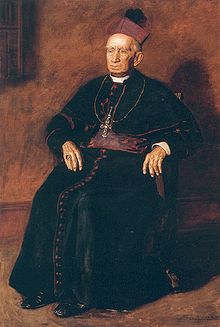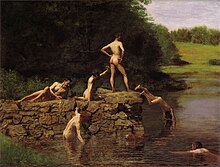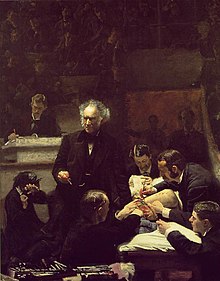Thomas Eakins
Jump to navigation
Jump to search

Thomas Cowperthwait Eakins (25 July 1844 – 25 June 1916) was an American painter, sculptor, photographer and art instructor.
Quotes[edit]












- We appreciate politeness when we are far from home. We may have different ideas of the word. An incivility or supposed incivility in a strange land cuts very deep and even a great or unlooked for kindness almost brings tears for one is apt to say to himself you are very good but maybe its because I'm a stranger, and he is forcibly reminded of home where kindness is taken thoughtlessly as a matter of course. Impressions are stronger away from home as you have discerned. If by politeness then is meant goodness, it is appreciated by me as I trust it always has been, but if it is to mean the string of ceremonies generally used for concealing ill nature, and which have been found necessary to the existence of every society whose members are wanting in self respect and morality, I detest it more than ever.
I have often used the word in both these acceptations, but I don't like it. My prominent idea of a polite man is one who is nothing but polish. It is an unenviable reputation. If there was anything else in him the polish would never be noticed. He is a bad drawing finely worked up, and Gérôme says that every attempt at finish on a bad design serves only to make the work more contemptible.- Letter to Emily Sartain (16 November 1866), published in The Paris Letters of Thomas Eakins (2009), edited by William Innes Homer
- When a man paints a naked woman he gives her less than poor Nature did. I can conceive of few circumstances wherein I would have to paint a woman naked, but if I did I would not mutilate her for double the money. She is the most beautiful thing there is — except a naked man, but I never saw a study of one exhibited.
- Letter to his father, Benjamin Eakins (1867), quoted in Thomas Eakins: His Life and Work (1933) by Lloyd Goodrich
- The big artist does not sit down monkey like & copy a coal scuttle or an ugly old woman like some Dutch painters have done nor a dungpile, but he keeps a sharp eye on Nature & steals her tools. He learns what she does with light the big tool & then colour then form and appropriates them to his own use. Then he's got a canoe of his own smaller than Nature's but big enough for every purpose except to paint the midday sun which is not beautiful at all. It is plenty strong enough though to make midday sunlight or the setting sun if you know how to handle it. With this canoe he can sail parallel to Nature's sailing. He will soon be sailing only where he wants to selecting nice little coves & shady shores or storms to his own liking, but if ever he thinks he can sail another fashion from Nature or make a better shaped boat he'll capsize or stick in the mud & nobody will buy his pictures or sail with him in his old tub.
- Letter to Benjamin Eakins (3 March 1868)
- In a big picture you can see what o'clock it is afternoon or morning if it's hot or cold winter or summer & what kind of people are there & what they are doing and why they are doing it. The sentiments run beyond words. If a man makes a hot day he makes it like a hot day he once saw or is seeing if a sweet face a face he once saw or which he imagines from old memories or parts of memories & his knowledge and he combines never creates but at the very first combination no man & less of all himself could ever disentangle the feelings that animated him just then & refer each one to its right place.
- Letter to Benjamin Eakins (3 March 1868)
- A teacher can do very little for a pupil and should only be thankful if he don't hinder him, and the greater the master, mostly the less he can say.
- Letter to Benjamin Eakins (29 November 1869)
- I have seen big painting here. When I had looked at all the paintings by all the masters I had known I could not help saying to myself all the time, it's very pretty but it's not all yet. It ought to be better, but now I have seen what I always thought ought to have been done and what did not seem to me impossible. O what satisfaction it gave me to see the good Spanish work so good so strong so reasonable so free from every affectation. It stands out like nature itself.
- Letter from Madrid to Benjamin Eakins (2 December 1869)
- My figures at least are not a bunch of clothes with a head and hands sticking out but more nearly resemble the strong living bodies that most pictures show. And in the latter end of a life so spent in study, you at least can imagine that painting is with me a very serious study. That I have but little patience with the false modesty which is the greatest enemy to all figure painting. I see no impropriety in looking at the most beautiful of Nature's works, the naked figure. If there is impropriety, then just where does such impropriety begin? Is it wrong to look at a picture of a naked figure or at a statue? English ladies of the last generation thought so and avoided the statue galleries, but do so no longer. Or is it a question of sex? Should men make only the statues of men to be looked at by men, while the statues of women should be made by women to be looked at by women only? Should the he-painters draw the horses and bulls, and the she-painters like Rosa Bonheur the mares and cows? Must the poor old male body in the dissecting room be mutilated before Miss Prudery can dabble in his guts?
Such indignities anger me. Can not anyone see into what contemptible inconsistencies such follies all lead? And how dangerous they are? My conscience is clear, and my suffering is past.- Letter of resignation to Edward Hornor Coates, Chairman of the Committee on Instruction, Pennsylvania Academy of the Fine Arts (15 February 1886)
- In pursuance of my business and professional studies, I use the naked model.
A number of my women pupils have for economy studied from each others' figures, and of these some have obtained from time to time my criticism on their work.
I have frequently used as models for myself my male pupils: very rarely female pupils and then only with the knowledge and consent of their mothers.
One of the women pupils some years ago gave to her lover who communicated it to Mr. Frank Stephens a list of these pupils as far as she knew them, and since that time Mr. Frank Stephens has boasted to witnesses of the power which this knowledge gave him to turn me out of the Academy, the Philadelphia Sketch Club, & the Academy Art Club, and of his intention to drive me from the city.- Letter to Emily Sartain (25 March 1886); Frank Stephens was Eakins' brother-in-law
- As some of you know, I some years ago — a few — painted a picture of Mr. Whitman. I began in the usual way, but soon found that the ordinary methods wouldn't do — that technique, rules and traditions would have to be thrown aside; that before all else, he was to be treated as a man, whatever became of what are commonly called the principles of art.
- Testimonial dinner for Walt Whitman on his seventy-second birthday, Camden, New Jersey (31 May 1891)
- I desire to sever all connection with the Society of American Artists. In deference to some of its older members, who perhaps from sentimental motives requested me to reconsider my resignation last year, I shall explain... For the last three years my paintings have been rejected by you, one of them the Agnew portrait, a composition more important than any I have ever seen on your walls.
Rejection for three years eliminates all elements of chance, and while in my opinion there are qualities in my work which entitle it to rank with the best in your Society, your Society's opinion must be that it ranks below much that I consider frivolous and superficial. These opinions are irreconcilable.- Letter to the Society of American Artists (7 May 1892)
- I taught in the Academy from the opening of the schools until I was turned out, a period much longer than I should have permitted myself to remain there.
My honors are misunderstanding, persecution and neglect, enhanced because unsought.- Letter to Harrison Morris (23 April 1894)
- On the lines of the mighty and simple strains dominating the movement, and felt intuitively and studied out by him, the master artist groups with full intention, his muscular forms. No detail contradicts. His men and animals live. Such is the work of three or four modern artists. Such was the work of many an old Greek sculptor.
- "The Differential Action of Certain Muscles Passing More than One Joint," lecture, Academy of Natural Sciences, Philadelphia (1 May 1894)
- I have never discovered that the nude could be studied in any way except the way I have adopted. All the muscles must be pointed out. To do this all the drapery must be removed.
- Said to art critic Riter Fitzgerald, who quoted Eakins in an article in the Philadelphia Item (1895); cited in Eakins (1967) by Sylvan Schendler, Ch. 10
- I once painted a concert singer and on the chestnut frame I carved the opening bars of Mendelssohn's "Rest in the Lord." It was ornamental unobtrusive and to musicians I think it emphasized the expression of the face and pose of the figure.
- Letter to Henry A. Rowland (4 October 1897)
- Strain your brain more than your eye... You can copy a thing to a certain limit. Then you must use intellect.
- Advice to his art students; quoted in Thomas Eakins: His Life and Work (1933) by Lloyd Goodrich
- If America is to produce great painters and if young artists wish to assume a place in the history of the art of their country, their first desire should be to remain in America to peer deeper into the heart of American life, rather than spend their time abroad obtaining a superficial view of the art of the Old World. In the days when I studied abroad conditions were entirely different. The facilities for study in this country were meagre. There were even no life classes in our art schools and schools of painting. Naturally one had to seek instruction elsewhere, abroad. Today we need not do that.
- Interview, Philadelphia Press, as quoted in Thomas Eakins: His Life and Work (1933) by Lloyd Goodrich
- I want to see the gardens and palace of the Alcazar where the Moorish Kings used to live. It is as perfect an architecture as the Egyptian, Greek or Gothic and just as beautiful, maybe more beautiful and it is well built for it looks as new as if it had just been done. We have to thanks these Moors for our greatest sciences, they did the big work for us, they started them, Algebra, Chemistry, Astronomy. They are our masters.
- As quoted in Vistas de España (2007) by Mary Elizabeth Boone, p. 77
Quotes about Eakins[edit]


- Whitman: And Eakins - What of Tom Eakins. He is here. Haven't you something to say to us Eakins?
Eakins: I am not a speaker.
Whitman: So much the better — you are more likely to say something.- Testimonial dinner for Walt Whitman on his seventy-second birthday (31 May 1891)
- I never knew of but one artist, and that's Tom Eakins, who could resist the temptation to see what they think ought to be rather than what is.
- Walt Whitman (16 April 1888), said in conversation with Horace Traubel and quoted by Traubel in With Walt Whitman in Camden (1906), vol. I
- Thomas Eakins was a man of great character. He was a man of iron will and his will to paint and to carry out his life as he thought it should go. This he did. It cost him heavily but in his works we have the precious result of his independence, his generous heart and his big mind. Eakins was a deep student of life, and with a great love he studied humanity frankly. He was not afraid of what his study revealed to him.
- Robert Henri, open letter to the Art Students League, (29 October 1917)
- He was never interested in conventional beauty. Sober, pinched, reflective, lined and melancholy, his portraits remind us of that. But how many American artists said more about the sense of being in the world? Eakins was that extreme rarity, an artist who refused to tell a lie even in the service of his own imagination.
- Robert Hughes, "Thomas Eakins," Nothing If Not Critical: Selected Essays on Art and Artists (1990)
External links[edit]
- Thomaseakins.org, 148 works by Thomas Eakins
- Thomas Eakins Exhibition at The Metropolitan Museum of Art
- Thomas Eakins letters online at the Smithsonian Archives of American Art
- Selections from the Seymour Adelman collection, 1845–1958 features a collection of documents relating to Eakins and his family from the Archives of American Art
- Works by Thomas Eakins at Bryn Mawr College
- Thomas Eakins: Scenes from Modern Life (2002) WHYY, Incorporated, and PBS documentary
- Profile at Find A Grave


